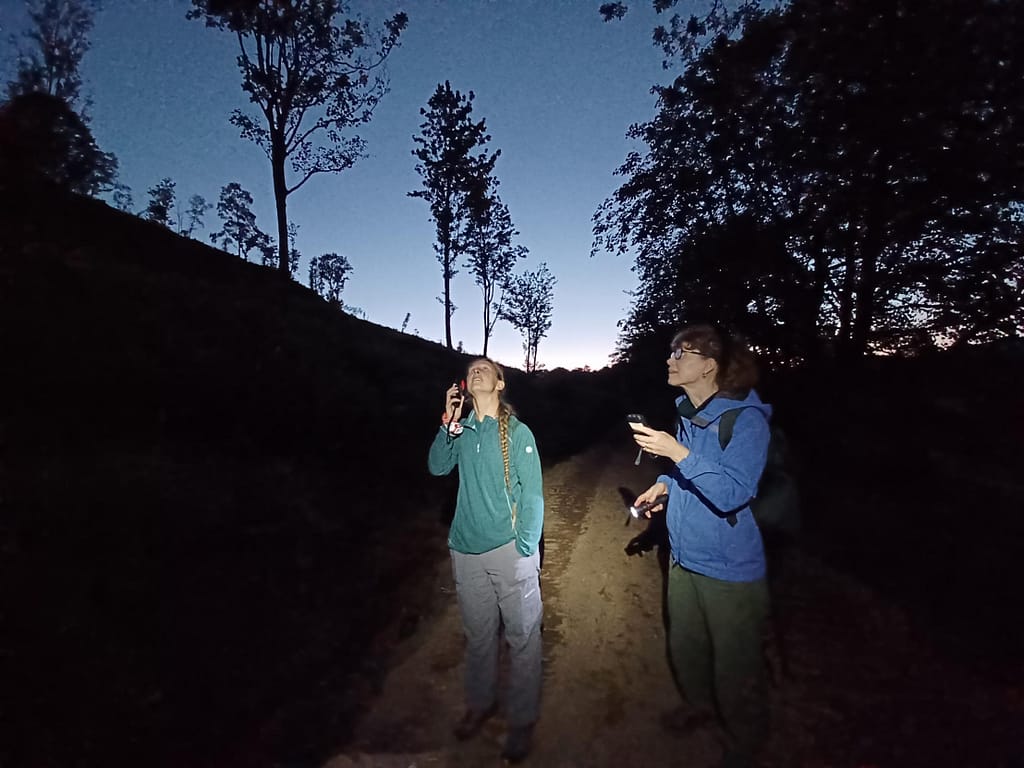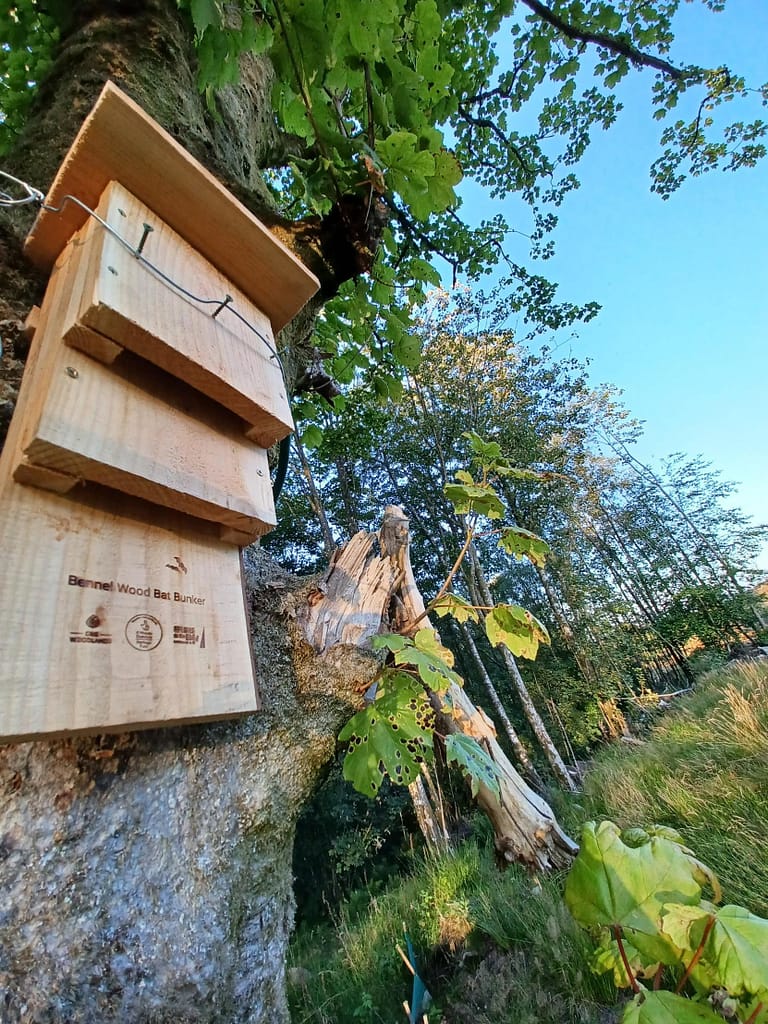To support the ‘Bennel Wood – Woodland Laboratory’ project, we’ll be posting a series of blogs as we learn more about natural regeneration and the influence different treatments have on what grows on (and lives in!) a recently felled commercial site.
The sixth blog is by Jack Barton from the Species on the Edge Project, looking back at a Bat Event held this summer…

Back in the spring I approached Dumfries and Galloway Woodlands to talk about bats. As I will explain more about in this blog, bats and trees are strongly interlinked, so who better to approach than the region’s foremost tree charity? Furthermore, like Species on the Edge, D&G woodlands have a strong ambition to share learning and inspire the public about their local environment. Naturally I envisaged an opportunity for partnership working. McNabb and Phil were exceptionally keen to incorporate bats into their work, particularly at their Bennel Wood site, where there was so much potential to learn and showcase.
Species on the Edge is a collaboration of eight conservation organisations, working with communities across Scotland’s coastal and island regions to save our rarest and most vulnerable species from extinction. One of the project partners is the Bat Conservation Trust. At its core, Species on the Edge is a species focused project, and four bat species are included within the project: Common Pipistrelle, Soprano pipistrelle, Brown Long-eared Bat and Daubenton’s Bat. So, despite me having a background in birds and being employed by the RSPB, that is how I have come to advocate for these creatures of the night!
I know what many readers might be thinking. ‘Are bats really that rare and vulnerable?’. It is certainly common to see one an evening stroll, true enough. Undoubtedly, bats are more abundant than some other Species on the Edge species such as the Tadpole Shrimp or Natterjack Toad. In the 20th century there were significant bat declines due to a cocktail of agricultural intensification, pollution, loss of habitat and roosts through development, and exclusion from buildings. So, when structured bat monitoring began in 1999, populations were at a very low ebb. In general, bat numbers in Scotland are thought to be stable, but there is a level of uncertainty around this as bat populations in Scotland are not very well understood. One growing threat is climate change, but how exactly this will affect our bats remains to be seen.
One critically important habitat for bats is trees. All bats in Scotland rely on trees to some extent. Trees, especially old and gnarly trees, can support a range of features that bats use to roost. Bats can make use of even the tiniest and most non-descript spaces. A roost is a place where bats live, whether that be during breeding, winter hibernation, or just a place to shelter when they are not foraging for food. Features such as woodpecker holes, lifted bark, lightning strikes, cavities, cracks and crevices, and old-growth ivy can all support roosting bats.
Trees also support a wide range of invertebrates which provide a source of food for bats. All Scottish bats will use habitats containing trees for foraging to some extent. Some bats, such as the Brown Long-eared Bat, are specialists at foraging in woodland and are beautifully adapted to hunting in this environment. Brown long-eared bats will use their incredibly attuned sense of hearing, provided by their elongated ears, to listen for insects in the canopy, and then glean them off the leaf surface!

Being a recent clear-fell site, stripped of trees except for those on the periphery, in its current state Bennel Wood is at the beginning of its regenesis. That doesn’t mean that bats won’t be using the site. One thing I was pleased to discover when visiting Bennel with other D&G woodlands members was how the site fits into a patchwork of other woodlands and nature-friendly sites in the area. Bats will commute some distance between roosting and foraging sites, using features hedgerows for cover. I would encourage D&G Woodlands to think about how to increase their connectivity with other sites in the area.
To discover which bats are using the site, in June I deployed an AudioMoth device for three nights. AudioMoths are what are known as a Passive Acoustic Monitoring devices, and consist of a small microphone, memory card and recording software. Bats use echolocation, a series of high-pitched sounds that bounce off objects, to navigate and hunt in the dark. Therefore, I set up the device to passively record from sunset to sunrise all high frequency sounds. This produced hours of recordings, which will be sent to BCT for analysis. Different bat species will echolocate at different peak frequencies, and the sonogram of their calls will have different patterns and features which will help determine what species were recorded.
In August, we ran a joint bat event at Bennel Wood. One main premise of this event was to give away bat boxes to event attendees so that they could put them up at home to help provide extra habitat for roosting bats. Bat boxes are simple wooden structures containing several internal crevices which the bats can crawl into. The bat boxes which we gave away at the event were kindly produced for us by Dalbeattie Men’s shed, as we were keen to keep the project local. We erected one of these boxes at Bennel Wood, where there is currently a lack of natural roosting features for bats.
Following an introductory talk by me and Phil, we set off along the path that runs along the lower edge of Bennel, equipped with heterodyne bat detectors. These detectors help us tune into the secret world of bat echolocation! I was apprehensive as I didn’t know what to expect from a clear-fell site. As the sun set, we detected our first bat of the evening, a Noctule Bat, flying high across the site and echolocating loudly. Noctule Bats are our largest bat species, with a wingspan of up to 40cm, and are a woodland specialist. The stars of the show that evening were the Soprano Pipistrelle bats, which provided constant entertainment for the evening. These small bats, which weigh as little as 5g, were enjoying foraging along the woodland at the edge of the site. It was fantastic listening to them on the bat detectors, their calls sounding like a rapid series of ‘wet-slaps’. Bats are incredibly nimble, and they flew right past our heads, not seeming to mind our presence, as they hunted for midges and small flies. The bats were clearly telling us that the site is rich in insect life, and a good place to forage!
Our event at Bennel was very enjoyable, and the bat activity surpassed everyone’s expectations. We have already enjoyed seeing photographs of bat boxes being erected at home by the attendees. Whether you have a small garden or own a larger area of land, find out what more you can do to help bats on the Bat Conservation Trust Website. This e-leaflet provides a wealth of information about bats and woodland.
Blog Words + photos = Jack Barton, September 2025
